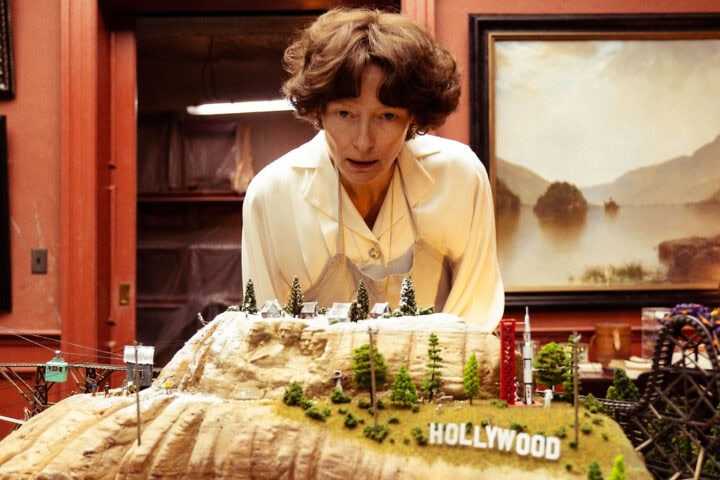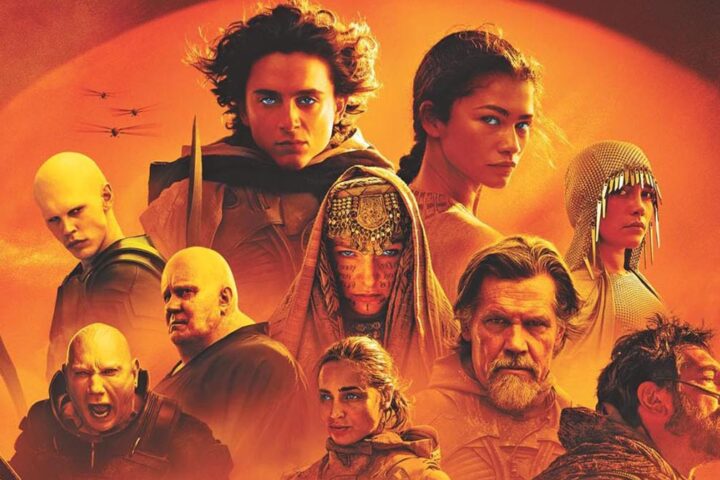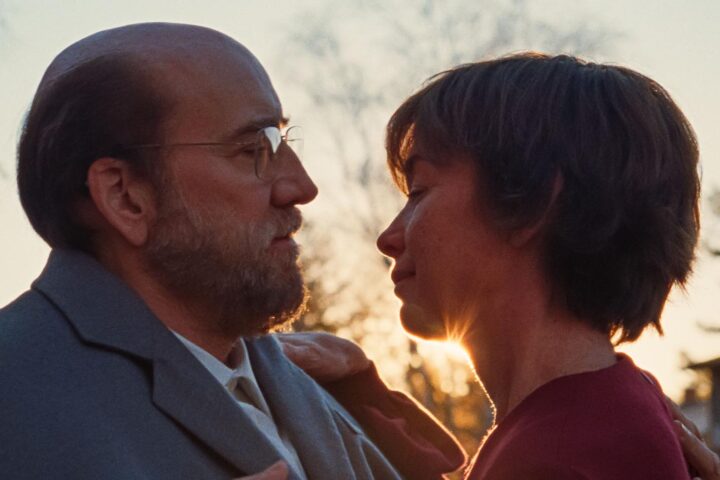“The great rooms caused so much poetry and history to press upon him that he needed some straying apart to feel in a proper relation with them,” wrote Henry James early in his 1903 novella The Beast in the Jungle, the loose inspiration for writer-director Bertrand Bonello’s disquieting and spectacular The Beast. James is describing the house in which his protagonist, John Marcher, crosses paths with the woman, May Bertram, who will prove not to be the love of his life, mainly because of Marcher’s unwillingness to take a risk on intimacy. This is due to his fear of a “beast” that he feels could pounce at any moment.
That beast isn’t anything concrete or corporeal, but rather a metaphorical unease—a dread of all the terrible things that life could mete out. And as Marcher discovers at the end of James’s novella, the beast has struck without him ever realizing it. Turns out, the man’s lifelong caution doomed him to the loss of the great romantic partner he never had.
Calamitous passivity of this sort is cultivated by context. Few equal James in his ability to evoke the milieus of the late-19th to early-20th centuries that constrict so many of his characters. And Bonello has a no less uncanny ability to utilize the burdensome signs and wonders of his moment for maximum insight and agitation. The Beast’s unnerving first scene plays out against a floor-to-ceiling green screen in a seemingly cavernous studio space. Actress Gabrielle (Léa Seydoux) takes direction from an off-screen interlocutor, his voice and prompts provided by Bonello à la Brian De Palma in the discomfiting screen test sequences of The Black Dahlia.
Like Marcher, Gabrielle is in a “house,” and she too has a “beast”—an unknown intruder who she must fend off with a kitchen knife (the only physical prop at hand). Once “action!” is called, her eyes dart manically from side to side and her body jerks defensively this way and that. “Poetry” and “history” aren’t pressing upon her so much as the fears and desires of an individual imagination run wild. And, of course, when Gabrielle finally screams at the sight of the interloper, she’s reacting to nothing—only a “beast” to be added in post-production. How can one feel “in a proper relation” to what is effectively a nullity within a void?
This is just one of the many questions that The Beast poses and leaves us to ponder as its sprawling canvas expands and contracts before us. James collapsed several decades into an 80-page short story, while Bonello interweaves three time periods over his film’s 146-minute runtime. The first is Paris 1910 during the Great Flood that devastated the city, the second is Los Angeles circa 2014 at an especially apprehensive sociopolitical inflection point, and the third takes us back to Paris in 2044 after AI has usurped humanity as the planet’s dominant species.
Gabrielle recurs in all three timelines, as does Louis (George MacKay, in a role originally intended for the late Gaspard Ulliel), the man fated, forever and always, to be her non-beloved. The switch of narrative perspective from man to woman doesn’t feel like a riposte to James, who certainly created his fair share of fully rounded female characters. And it’s quite evident anyway that Bonello isn’t out to shallowly feminize a masculine-centered parable. If anything, both Gabrielle and Louis, and the superb performers playing them, have a doll-like interchangeability that makes The Beast seem like a punk-philosophical reworking of Greta Gerwig’s Barbie.
Dolls are a recurring motif in the film. The 1910 Gabrielle, a pianist obsessed with Arnold Schoenberg’s atonal compositions, at one point eerily demonstrates to Louis the “neutral” expression with which her toymaker husband’s creations are sculpted. In the 2014 section, a Chucky-like plaything acts as a disconcerting visual running gag. And by 2044, “dolls” are the titles given to the lifelike robot companions—Gabrielle’s is strikingly played by Saint Omer’s Guslagie Malanda—who help their mortal counterparts acclimate to a “cleansing” procedure that nullifies human emotion and makes people more productive members of society.
True to James, there’s a poetically literate ardor to the 1910 section with its allusive dialogue and visual sweep, one that by 2014 has curdled into a senses-fracturing ugliness given apocalyptic voice by an incel version of Louis, whose YouTube-esque ramblings are in many cases taken verbatim from those of misogynist serial killer Elliot Rodger. Is Bonello drawing a parallel between Rodger’s rageful psychopathy and James’s compulsive creative impulse, itself informed by an admittedly more willful celibacy? Perhaps better to say he’s spotlighting the thin line separating the two perspectives, as well as sketching the very different contexts that resulted in outcomes on the one hand life-giving and on the other death-dealing.
We’re all products of our time and circumstance, but how frequently do we push back against the forces—on the beasts both real and imagined—that keep us in anonymizing check? And, having taken such risks, how often do our own stories still end in tragedy? But then again, is the endpoint, our endpoint, the true crux of the matter? Another line from James’s novella illuminates what is likely Bonello’s larger goal: “It wouldn’t have been failure to be bankrupt, dishonored, pilloried, hanged; it was failure not to be anything.” What The Beast captures is the ceaseless cycle of two people failing to be over several lifetimes, in certain instances because of circumstances beyond their control, and in others because of their own purposeful inertia.
Not that we’re ever permitted a firm grip on their ambitions, or lack thereof. Both Gabrielle and Louis remain slippery figures, conjured (and re-conjured) from an abyss that also often consumes them. Throughout, Bonello consistently shifts the linguistic and aesthetic ground: Conversations move seamlessly between French and English, and digital smears and blemishes occasionally erupt on the images like painterly pustules. There’s even an on-screen earthquake at one point that literalizes the film’s numerous stylistic and thematic fissures.
So many of The Beast’s visions are impossible to shake, from a submerged basement flecked with floating dead rats to a futuristic nightclub that reinvents itself every night in homage to a different year. (This endlessly adaptable locale affords Bonello the opportunity to employ alternately pointed and poignant needle drops from the Pointer Sisters, Visage, and Roy Orbison). Nothing, though, hits with as much force as the film’s climactic moments, which transpose James’s cataclysmic portrait of a guarded man animalistically hurling himself on a grave to sci-fi speculative territory mined, in similarly shattering fashion, in Je T’aime, Je T’aime, A.I. Artificial Intelligence, and Twin Peaks: The Return. The influences may be evident, but the sentiments and sensations evoked by The Beast’s finale—a shriek-inflected dance duet performed, in essence, by the walking dead—are entirely, elatingly Bonello’s own.
Since 2001, we've brought you uncompromising, candid takes on the world of film, music, television, video games, theater, and more. Independently owned and operated publications like Slant have been hit hard in recent years, but we’re committed to keeping our content free and accessible—meaning no paywalls or fees.
If you like what we do, please consider subscribing to our Patreon or making a donation.




